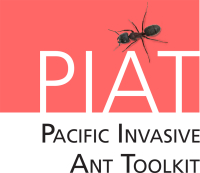Pre-export
Prevention is always better (and cheaper) than cure. Studies of the “pathways” used by invasive ant species have shown that around 65% of all invasive ants found at the border entered the country in or on sea containers. Other likely pathways for ants include imported vehicles, machinery, fresh produce, timber and soils.
Membership of international organizations : Pre-export hygiene systems : Import Health Standards
Membership of international organizations
There are several international organizations that promote biosecurity and the development of international trade by creating standards and procedures that their member countries agree to follow. These organizations include:
- The World Trade Organization (WTO) - develops rules for trade including the development of standards to prevent the spread of pests and diseases through trade. Members of the WTO are requested to abide by the SPS Agreement. The standards are developed by the mandated organisations: IPPC, OIE and CODEX Alimentarius
- The International Plant Protection Convention (IPPC) - sets standards for plant health
- The World Organization for Animal Health (OIE) - provides standards for animal health and managing diseases that can be transmitted from animals to humans (zoonoses)
- CODEX Alimentarius - or "Food Code" was established by FAO and the World Health Organization (WHO) in 1963 to develop harmonised international food standards, which protect consumer health and promote fair practices in food trade
Members of these organizations must abide by the WTO Sanitary and Phytosanitary (SPS) Agreement.
The SPS agreement states that:
- members have the right to protect human or plant or animal health provided the restrictions imposed to do so are in line with the SPS agreement.
- any restrictions on trade for health reasons must justified by a scientific risk analysis based on sound scientific principles
- members must not unjustifiably use health restrictions as a means of preventing the import of goods in favour of domestic produce or to favour one country’s exports over another’s.
Membership of these organizations can assist in the development of best practice biosecurity protocols.
Pre-export hygiene systems
Efficient hygiene systems can reduce the risk of contaminated cargo by cleaning prior to export. If they are adopted by all trading partners, these type of systems benefit all countries involved.
The Sea Container Hygiene System (SCHS) is a pre-border biosecurity system that involves cleaning the interior and exterior of every sea container at its port of origin, then storing the container in a clean (pest free) holding area that has ongoing baiting and prophylactic pest control. The principles of this type of system can also be effectively used to improve biosecurity between islands in a nation.
Similarly air containers should only be held at approved landing sites (e.g. specified airports) and all containers must be free from contamination inside and out. The containers should be taken to a designated inspection area. It is essential that this area is kept clean and free of ants (and other) species.
Import Health Standards (IHS) - and equivalents elsewhere
Countries use various standards and permits to manage the conditions under which goods can be imported. In New Zealand - used here as an example of best practice - these are import health standards (IHS). Other countries use biosecurity import permits (e.g. Fiji, Kiribati) or phytosanitary import permits (Cook Islands), or other standards. The intent is the same regardless of the name, and the conditions are typically similar as they follow international guidelines.
Import Health Standards (IHSs) are documents issued under the Biosecurity Act (or equivalent) of a country, which state the requirements that must be met before goods can be imported. These requirements are based on an Import Risk Analysis. In some countries (such as New Zealand) items that are not covered by an IHS may not be imported under any circumstances. The requirements of an IHS typically revolve around the cleanliness of the item(s) at export and stipulate that the commodity should be free of any animals, insects, or other invertebrates, organic material of animal origin, plant material or soil.
The exporter must have a documented procedure that complies with the requirements of the IHS. These procedures may include fumigation, heat treatment and storage in a designated clean area. The importer must monitor to make sure that this procedure is followed.
Depending on the agreements between the exporting country’s National Plant Protection Organization (NPPO) and the issuer of the IHS, a certificate from an Official Assurance Programme (OAP) may be accepted. The certificate indicates that the area the export departed from is clear of a particular invasive pest species. This OAP may be issued as a result of the exporting country’s own surveillance programme.
Any item that does not comply with the cleanliness or other requirements of the IHS should be decontaminated (at the exporters cost), reshipped or destroyed.
For example, the New Zealand IHS for Sawn Wood from All Countries is informed by the Import Risk Analysis for Ants on Sawn Timber Imported from the South Pacific Region.
More examples of New Zealand Import Health Standards can be found here.
content reviewed by Souad Boudjelas, Pacific Invasives Initiative, November 2016
